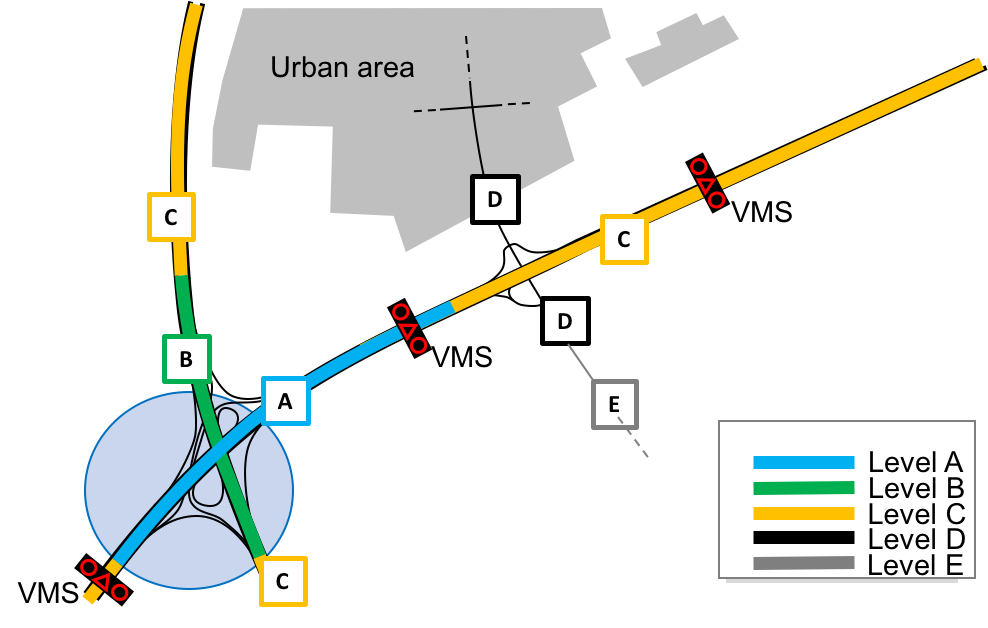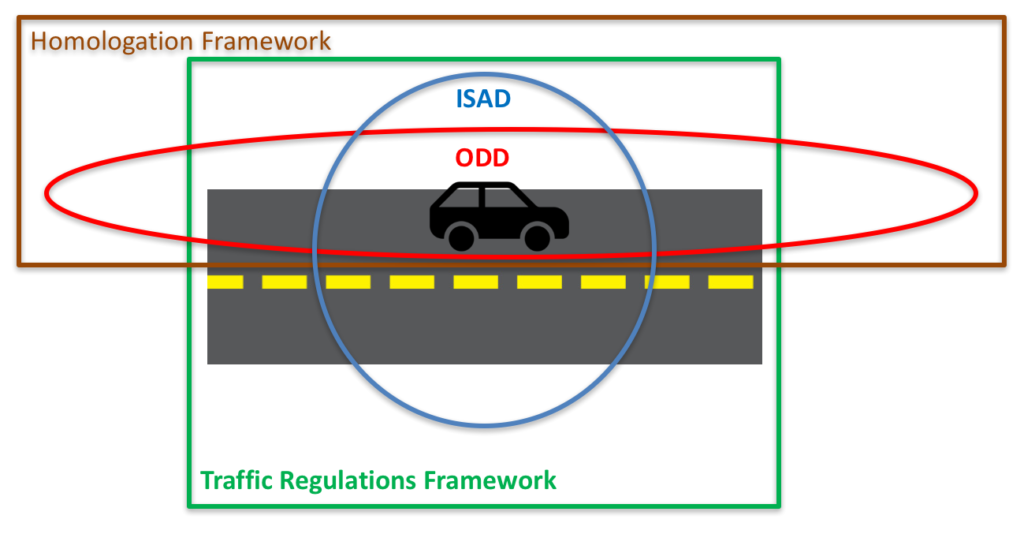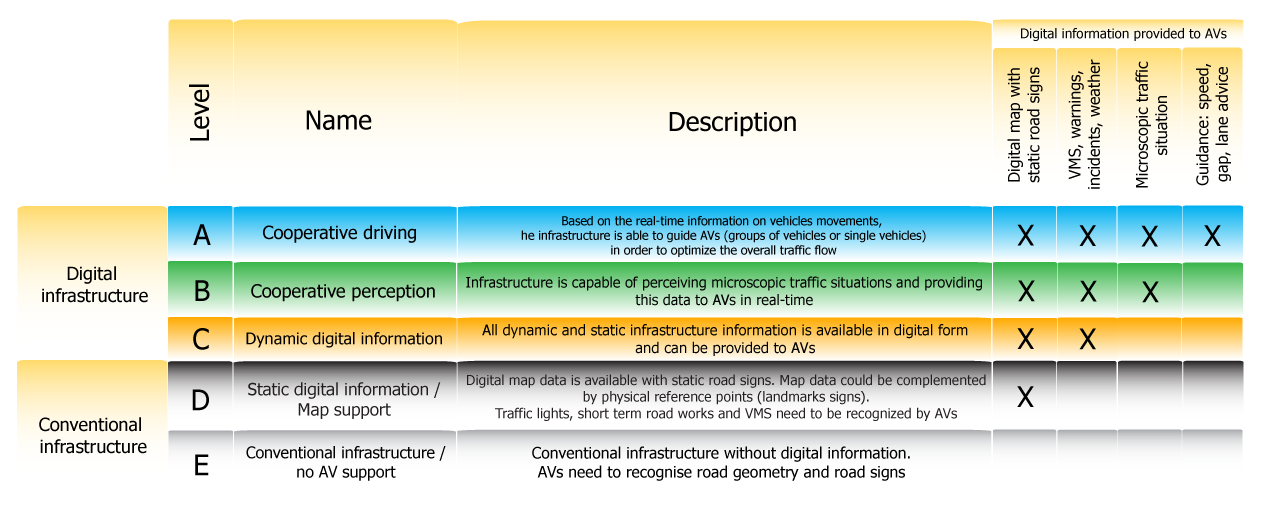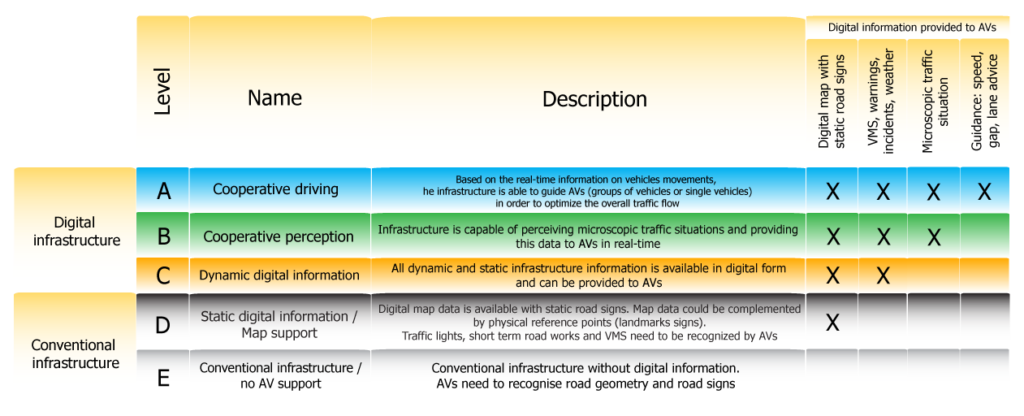Infrastructure Categorization: ISAD levels
The environmental perception of automated vehicles is limited by the range and capability of on‐board sensors. Road infrastructure operators already employ numerous traffic and environmental sensors and provide information that can be perceived by automated vehicles. In order to classify and harmonize the capabilities of a road infrastructure to support and guide automated vehicles, we propose a simple classification scheme, similar to SAE levels for the automated vehicle capabilities. These levels can be assigned to parts of the network in order to give automated vehicles and their operators guidance on the “readiness” of the road network for the coming highway automation era.
Categorization: Infrastructure Support Levels for Automated Driving (ISAD)
Levels of the Infrastructure Support for Automated Driving (ISAD Levels).
The ISAD levels start with the conventional infrastructure without any support for automation (Level E). The availability of a digital map with static regulatory information (e.g. speed limits) is assigned to Level D. At Level C begins the full digitalization of infrastructure elements and thus the availability of all relevant digital information in digital form, esp. VMS, traffic lights, which can be extended by further environment information. Level B describes infrastructures that are able to perceive complete traffic situations on a microscopic basis by specialized sensors (e.g. fixed infrastructure radars). This sensor data could be augmented by data coming from vehicles such as probe vehicle data, and more advanced cooperative perception messages. However, using this data alone does not provide microscopic traffic perception capability as it relies on the equipment of vehicles. At Level A the infrastructure uses its traffic perception capabilities for microscopic traffic management. Microscopic traffic management goes beyond dynamic speed limits (currently displayed on VMS) and provides optimal speed advice, lane usage and lane change recommendations, advice on inter-vehicle gaps etc. to automated and connected vehicles.
Based on the ISAD Level of information and services different onboard vehicle decisions can be supported. CAVs will have to be able to drive on E-level, but the additional possibilities provided by A-level sections enable a much higher customer satisfaction as well as road safety and capacity management-related goals.
Use of ISAD levels
Infrastructure support levels are meant to describe road or highway sections rather than whole road networks. This reflects the common practice of infrastructure deployment: Traffic control systems, such as sensors and Variable Message Signs (VMS), are usually deployed on motorway sections where traffic often reaches the capacity limit (e.g. in metropolitan areas), whereas other motorway sections need no fixed installations of traffic control systems because traffic flow is rarely disrupted. The figure below shows an example of how ISAD levels could
describe the changing support along motorway segments.

Examples of ISAD Levels assigned to a road network.
If a complex intersection is covered by dedicated traffic sensors, traffic situation awareness (level B) and even AV guidance (level A) could be provided. Other sections provide only level C support, which includes that VMS data is made available via digital interfaces. Furthermore, in this example the secondary road network is covered partially by map support (Level D), some rural areas have no support. This example illustrates how ISAD levels can be used for a simple description of what automated vehicles can expect on specific parts of a road network.
Interaction: Operational Design Domain (ODD) / ISAD / Traffic Regulations
INFRAMIX long term vision is to align infrastructure data with automotive safety integrity level. Also, we are analysing automated driving quality and availability as well as driving/travel experience from a user perspective.

The interaction between ISAD levels, ODDs and traffic regulations.
How the infrastructure can (and should) support CAD
- Road infrastructure can provide additional information for onboard decisions on CAVs
- A classification of infrastructure support is needed for:
-
- Promoting common understanding among OEMs, automotive industry and road operators;
- Defining more use-cases to understand the potential of ISAD in mixed traffic;
- Tackling a long transition period with mixed traffic.
You can read more about ISAD here . Also, have a look at our testing sites on the dedicated page.


